#m32 galaxy
Explore tagged Tumblr posts
Text
Samsung Galaxy M32 5G - Price in India, Specifications & Features | Mobile Phone
Samsung Galaxy M32 5G Price in India (2024): ₹20,999 to ₹21,999. Know the specifications and review of Samsung Galaxy M32 5G. Check out the prices of Samsung Galaxy M32 5G in different stores. Samsung कर दिया M -सीरीज में सबसे पावरफुल फ्लैगशिप 5G स्मार्टफोन लॉन्च Samsung Galaxy M32 5G यह फोन उन यूजर्स के लिए बेहतरीन हैं, जो 5G कनेक्टिविटी, पावरफुल परफॉर्मेंस, और स्टाइलिश डिजाइन वाले फोन को कम…
#Mobile#Samsung galaxy j15 prime price in bangladesh#Samsung galaxy j15 prime price in pakistan#Samsung Galaxy M32#Samsung Galaxy M32 5G#Samsung Galaxy M32 5G Amazon India#Samsung Galaxy M32 5G Camera Glass#Samsung Galaxy M32 5G details#Samsung Galaxy M32 5G display price#Samsung Galaxy M32 5G in japanese yen#Samsung Galaxy M32 5G in Philippines#Samsung galaxy m32 5g launch date#Samsung Galaxy M32 5G launch date in India#Samsung galaxy m32 5g price#Samsung Galaxy M32 5G price in bangladesh#Samsung Galaxy M32 5G price in china#Samsung Galaxy M32 5G price in India#Samsung Galaxy M32 5G price in pakistan#Samsung Galaxy M32 5G reviews#Samsung Galaxy M32 5G specifications#Samsung Galaxy M32 5G usa price#samsung j15 prime price in bangladesh#samsung j15 prime price in pakistan#Samsung M32 5G (6GB 128GB)#Samsung M32 5G Samsung Galaxy M32 5G Smartphone#Today Wold
0 notes
Text

Swift’s UV Portrait of the Andromeda Galaxy
NASA's Neil Gehrels Swift Observatory viewed the spiral galaxy Andromeda. (Also called M31, in Ultraviolet light). The image is composed of 330 images from Swift's Ultraviolet Optical Telescope. 20,000 ultraviolet sources are visible in the photo, including M32, which is a small galaxy in orbit around M31.
Image Credits: NASA/Swift/Stefan Immler (GSFC) and Erin Grand (UMCP)
#astronomy#deep space#galaxy#outer space#nasa#planets#space#stars#aesthetic#nasa science#purple aesthetic#andromeda#constellations#space exploration#space telescopes
87 notes
·
View notes
Text

Hubble's 2.5 Gigapixel Camera
So you got yourself a 2.5 Gigapixel camera, what would you take with it ? This particular one is in Earth orbit, and it turned it's attention to the Andromeda Galaxy.
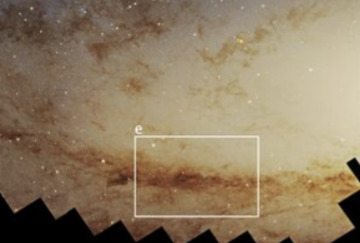
Zooming in to different areas of the galaxy, you get a spectacular view, here is a dust lane., common in spiral arms.
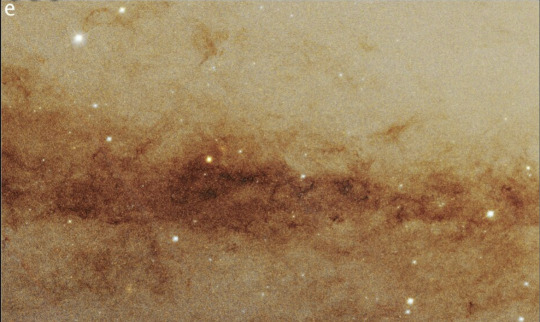
and closer in.
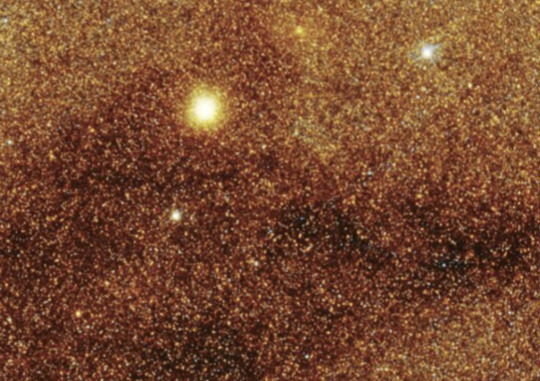
and the M32 dwarf galaxy which you can see in the upper left of the top image.
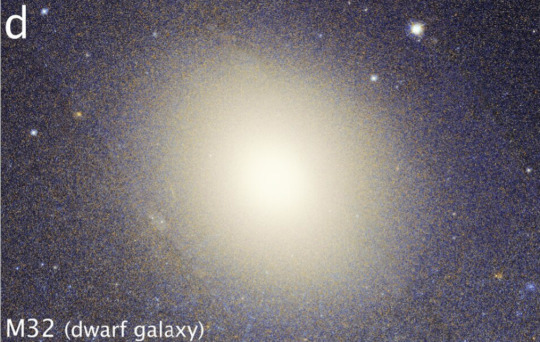
and to zoom in again.
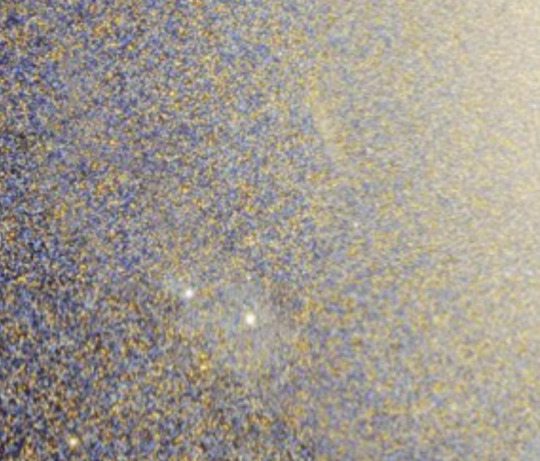
Thankfully, ESA has uploaded a lovely zoomable website, where you can zoom in to any part of the Andromeda galaxy.
Enjoy !
72 notes
·
View notes
Text
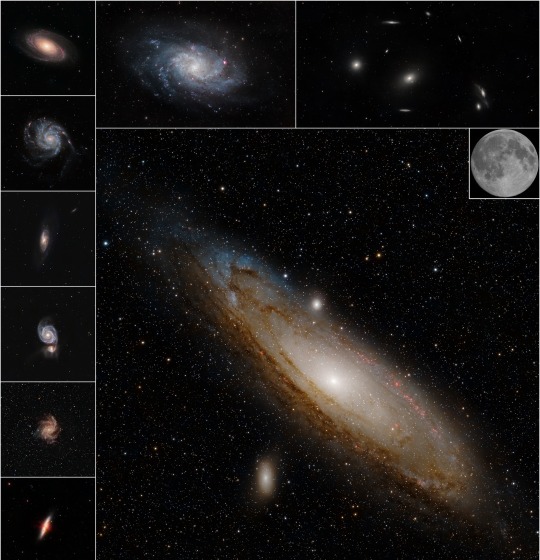
This is a size comparison of the major galaxies I've managed to shoot thus far, as well as a shot of the full moon for reference. Most of these were shot with an ED127 at native focal length, and some with a reducer while M31 was shot with a Redcat 51. All have been corrected to appear at the same image scale.
1100 Megapixel
On the left from top to bottom are M81 (Bode's Galaxy), M101 (Pinwheel Galaxy), M106, M51 (Whirlpool Galaxy), NGC6946 (Fireworks Galaxy), and M82 (Cigar Galaxy). Top center is M33 (Triangulum Galaxy) and the large photo is M31 (Andromeda Galaxy) and its satellite galaxies M32 and M110. Top right is Markarian's Chain, a collection of galaxies including M84, M86, NGC4402, NGC4388, NGC4425, NGC4435, and NGC4438 (among several others)
#galaxies#galaxy#astronomy#nasa#astronomers#universe#nasa photos#astrophotography#outer space#astrophysics#nasawebb#hubble space telescope#space travel#space program#international space station#space exploration#space#james webb space telescope#space science#nasa science#science facts#planetary science#science#planetary nebula#our universe#the universe#cosmos#astronomy facts#nasa astronauts#nasa picture of the day
89 notes
·
View notes
Text
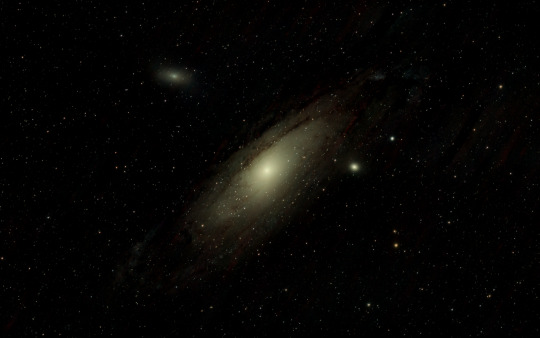
50x30s(25mins) 6400iso of M31, the Andromeda galaxy, and her companions, M32 and M110
Processed in Siril and Graxpert
Sorry for taking so long to post this! I've got a couple more decent images coming soon that I just need to process a little!
For how bad the noise was in the original stack, I think I did a pretty good job of getting nearly all of it out.
26 notes
·
View notes
Text

Andromeda’s satellite galaxies
Located 2.5 million light-years away, the majestic Andromeda galaxy appears to the naked eye as a faint, spindle-shaped object roughly the angular size of the full Moon. What backyard observers don't see is a swarm of nearly three dozen small satellite galaxies circling the Andromeda galaxy, like bees around a hive.
These satellite galaxies represent a rambunctious galactic "ecosystem" that NASA's Hubble Space Telescope is studying in unprecedented detail. This ambitious Hubble Treasury Program used observations from more than a whopping 1,000 Hubble orbits. Hubble's optical stability, clarity, and efficiency made this ambitious survey possible. This work included building a precise 3D mapping of all the dwarf galaxies buzzing around Andromeda and reconstructing how efficiently they formed new stars over the nearly 14 billion years of the universe's lifetime.
In the study published in The Astrophysical Journal, Hubble reveals a markedly different ecosystem from the smaller number of satellite galaxies that circle our Milky Way. This offers forensic clues as to how our Milky Way galaxy and Andromeda have evolved differently over billions of years. Our Milky Way has been relatively placid. But it looks like Andromeda has had a more dynamic history, which was probably affected by a major merger with another big galaxy a few billion years ago. This encounter, and the fact that Andromeda is as much as twice as massive as our Milky Way, could explain its plentiful and diverse dwarf galaxy population.
Surveying the Milky Way's entire satellite system in such a comprehensive way is very challenging because we are embedded inside our galaxy. Nor can it be accomplished for other large galaxies because they are too far away to study the small satellite galaxies in much detail. The nearest galaxy of comparable mass to the Milky Way beyond Andromeda is M81, at nearly 12 million light-years.
This bird's-eye view of Andromeda's satellite system allows us to decipher what drives the evolution of these small galaxies. "We see that the duration for which the satellites can continue forming new stars really depends on how massive they are and on how close they are to the Andromeda galaxy," said lead author Alessandro Savino of the University of California at Berkeley. "It is a clear indication of how small-galaxy growth is disturbed by the influence of a massive galaxy like Andromeda."
"Everything scattered in the Andromeda system is very asymmetric and perturbed. It does appear that something significant happened not too long ago," said principal investigator Daniel Weisz of the University of California at Berkeley. "There's always a tendency to use what we understand in our own galaxy to extrapolate more generally to the other galaxies in the universe. There's always been concerns about whether what we are learning in the Milky Way applies more broadly to other galaxies. Or is there more diversity among external galaxies? Do they have similar properties? Our work has shown that low-mass galaxies in other ecosystems have followed different evolutionary paths than what we know from the Milky Way satellite galaxies."
For example, half of the Andromeda satellite galaxies all seem to be confined to a plane, all orbiting in the same direction. "That's weird. It was actually a total surprise to find the satellites in that configuration and we still don't fully understand why they appear that way," said Weisz.
The brightest companion galaxy to Andromeda is Messier 32 (M32). This is a compact ellipsoidal galaxy that might just be the remnant core of a larger galaxy that collided with Andromeda a few billion years ago. After being gravitationally stripped of gas and some stars, it continued along its orbit. Galaxy M32 contains older stars, but there is evidence it had a flurry of star formation a few billion years ago. In addition to M32, there seems to be a unique population of dwarf galaxies in Andromeda not seen in the Milky Way. They formed most of their stars very early on, but then they didn't stop. They kept forming stars out of a reservoir of gas at a very low rate for a much longer time.
"Star formation really continued to much later times, which is not at all what you would expect for these dwarf galaxies," continued Savino. "This doesn't appear in computer simulations. No one knows what to make of that so far."
"We do find that there is a lot of diversity that needs to be explained in the Andromeda satellite system," added Weisz. "The way things come together matters a lot in understanding this galaxy's history."
Hubble is providing the first set of imaging where astronomers measure the motions of the dwarf galaxies. In another five years Hubble or NASA's James Webb Space Telescope will be able to get the second set of observations, allowing astronomers to do a dynamical reconstruction for all 36 of the dwarf galaxies, which will help astronomers to rewind the motions of the entire Andromeda ecosystem billions of years into the past.
The Hubble Space Telescope has been operating for over three decades and continues to make ground-breaking discoveries that shape our fundamental understanding of the universe. Hubble is a project of international cooperation between NASA and ESA (European Space Agency). NASA's Goddard Space Flight Center in Greenbelt, Maryland, manages the telescope and mission operations. Lockheed Martin Space, based in Denver, also supports mission operations at Goddard. The Space Telescope Science Institute in Baltimore, which is operated by the Association of Universities for Research in Astronomy, conducts Hubble science operations for NASA.
IMAGE: This is a wide-angle view of the distribution of known satellite galaxies orbiting the large Andromeda galaxy (M31), located 2.5 million light-years away. The Hubble Space Telescope was used to study the entire population of 36 mini-galaxies circled in yellow. Andromeda is the bright spindle-shaped object at image center. All the dwarf galaxies seem to be confined to a plane, all orbiting in the same direction. The wide view is from ground-based photography. Hubble's optical stability, clarity, and efficiency made this ambitious survey possible. Hubble close up snapshots of four dwarf galaxies are on image right. The most prominent dwarf galaxy is M32 (NGC 221), a compact ellipsoidal galaxy that might be the remnant core of a larger galaxy that collided with Andromeda a few billion years ago. Credit NASA, ESA, Alessandro Savino (UC Berkeley), Joseph DePasquale (STScI), Akira Fujii DSS2
13 notes
·
View notes
Text
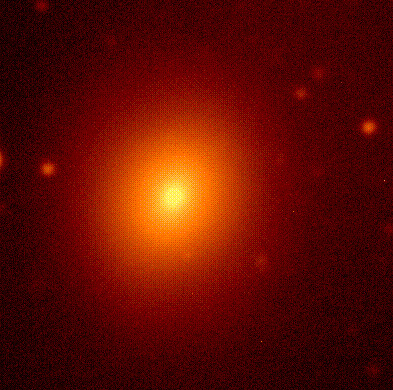
Dwarf Elliptical Galaxy M32 - January 6th, 1996.
"Being the largest galaxy around can sometimes make you popular. Pictured is M31's companion galaxy, M32. M31, the Andromeda galaxy, is the largest galaxy in our Local Group of galaxies - even our tremendous Milky Way galaxy is smaller. Little M32 is visible in most pictures of M31 - it is the small circular spot north of M31's center. M32 is a dwarf elliptical galaxy. Elliptical galaxies have little or no measurable gas or dust - they are composed completely of stars and typically appear more red than spiral galaxies. Elliptical galaxies do not have disks - they generally have oblong shapes and therefore show elliptical profiles on the sky."
73 notes
·
View notes
Text

The Andromeda Galaxy, M31 // JoeHenry
#astronomy#astrophotography#galaxy#spiral galaxy#star-forming galaxy#dwarf galaxy#elliptical galaxy#andromeda galaxy#messier#messier 31#M31#messier 32#M32#NGC 224#NGC 221#andromeda
48 notes
·
View notes
Text
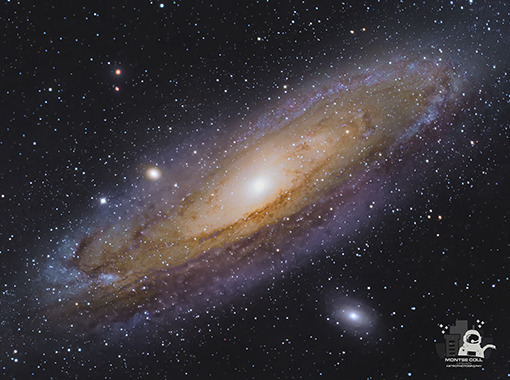
M31, NGC 224, Andromeda Galaxy , M32 & M110
Constellation of Andromeda
Distance: 2.9 million light years
Jul 26 2023 -Montcada i Reixac
#astrophotography#urban astrophotography#astrophotos#astro observations#cosmos#original photographers#astronomy#universe#original photographic works#andromeda#andromeda galaxy
57 notes
·
View notes
Text
Malcador's Knights of the Sigil (AKA Sigil Knights)
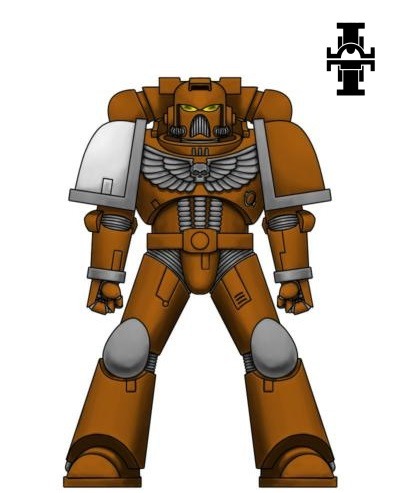
In the middle years of the Great Crusade, when the Emperor had not yet retired to Terra but the distance between the capitol world of the Imperium and the great Legions of the space marines was growing ever wider, a proposal came to the War Council. Drafted by Malcador the Sigilite, Regent of Terra, the proposal called for the creation of a unified force of space marines. They would be experts chosen from among the ranks of the various Legions, to be grouped together as a rapid response strike force. Thus they would serve the Imperium in those times when the assembly of the Imperial Army or the ponderous might of the Legions was inappropriate for the task at hand. In so doing they would serve as exemplars of the Astartes for the Imperium and foster goodwill between the Legions as those chosen for duty would carry the comradeship of such mixed units with them when they returned to their own Legion. Only five primarchs voted to support the proposal. The inauspicious beginning would come to characterize the Knights of the Sigil. Although more and more Legions would eventually send representatives, it soon became clear that many of the primarchs were unwilling to release their best and brightest from their service, and instead Legion headquarters sent such marines as were considered unfit for duty in their parent companies. Perhaps it was not helped that the color of their armor was chosen to be a burnished bronze - though symbolic of an alloy made strong by mixing metals, it also hearkened back to ancient Terran traditions of a third-rate presence: ranking behind the gold of the Custodians and the silver of the Knights-Errant. Despite such pressures - or perhaps because of them - the Sigil Knights would become a knight-knit group, ferociously loyal to one another and to Malcador himself, who they came to view as benefactor, the provider of one last refuge from disgrace. Amidst the myriad tragedies of the Horus Heresy came the sundering of Malcador's Knights of the Sigil. When those marines hailing from traitor Legions came under suspicion, many chose to renounce their heritage and be counted among the early Blackshields, the rest either joining them or donning the silver of the Knights-Errant and becoming individual operatives.
Though they received no great love in their lifetime or lamentation at their end, it is arguable that following the wars of M32 the foundation of the Deathwatch would use the groundwork laid by the Sigil Knights to create a galaxy-wide force operating in cohesive teams formed from the many chapters of the Adeptus Astartes.
18 notes
·
View notes
Text
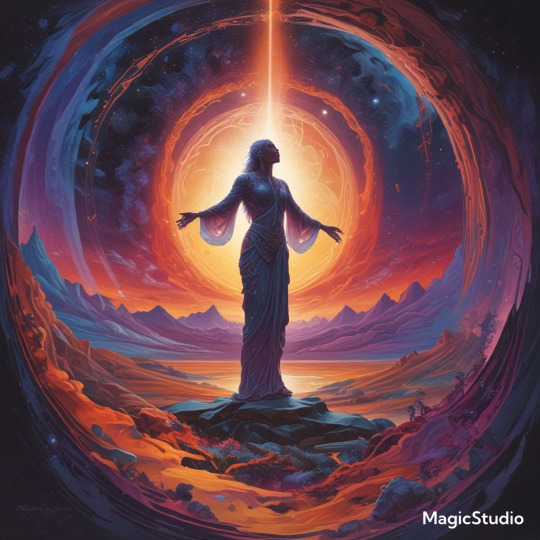
Unveiling the Cosmic Dance: From Milkomeda to Laniakea, Across the Vast Void
The vastness of the universe is impressive. It consists of billions of galaxies that extend over billions of light years. But within this immense expanse, our cosmic neighborhood, the so-called local universe, has a special significance. Here we find our home galaxy, the Milky Way, and countless other celestial bodies that shape our understanding of the cosmos. Let's embark on a journey through the local universe and explore the fascinating structures of galaxy groups, clusters and superclusters and their role in the larger structure of the cosmos.
Our immediate cosmic family is the Local Group, a collection of galaxies held together by gravity. This small-scale structure consists of the Milky Way, the Andromeda Galaxy (M31), the Triangulum Galaxy (M33), and about 50 dwarf galaxies. Although the Local Group may seem insignificant compared to the vastness of the Universe, it is a crucial laboratory for studying galaxy interactions and dynamics.
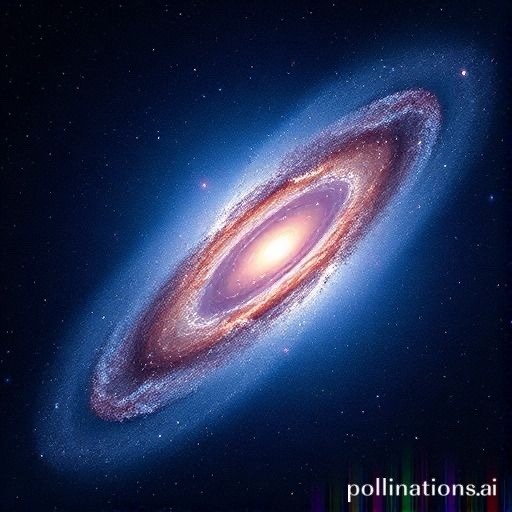
The Andromeda Galaxy, our nearest large star neighbor, is a stunning sight in the night sky. With its spiral arms and bright core, M31 is a prominent feature of the constellation Andromeda. The May 10, 2009 Astronomy Picture of the Day shows M31 and its companion, the elliptical galaxy M32, providing a stunning visual representation of the beauty and complexity of the Local Group.

One of the most fascinating aspects of the Local Group is the future collision between the Milky Way and the Andromeda Galaxy. In about 4.5 billion years, these two majestic galaxies will merge and form a new entity called "Milkomeda." This cosmic event highlights the dynamic nature of galactic interactions and the ever-evolving nature of our local Universe.
As we expand our view beyond the Local Group, we encounter larger and more diverse structures - galaxy groups and clusters. These are collections of galaxies held together by the gravitational forces that shape the Universe. Galaxy groups and clusters come in different sizes and densities, and each offers unique insights into the evolution and behavior of galaxies.

Paul Hickson identified Hickson Compact Groups as small, dense collections of galaxies. These groups are of particular interest because of their potential for galaxy mergers and interactions. In such a small space, galaxies can be subject to tidal forces, gas ejection and gravitational perturbations, leading to the formation of new types of galaxies and the reshaping of existing ones.
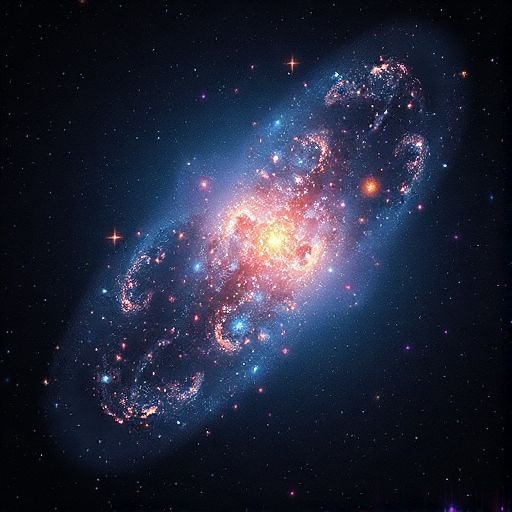
The Virgo Cluster is a prominent galaxy cluster in the local Universe, located in the constellation Virgo. It is a rich cluster containing thousands of galaxies, including giant elliptical galaxies and numerous spiral galaxies. The Virgo Cluster is a prime example of how galaxies gather and interact in a dense environment, influencing each other's evolution.
Rich galaxy clusters are cosmic giants containing thousands to tens of thousands of galaxies and huge amounts of hot gas. These clusters are not only impressive in size, but also crucial for understanding the distribution of matter in the universe and the role of dark matter.
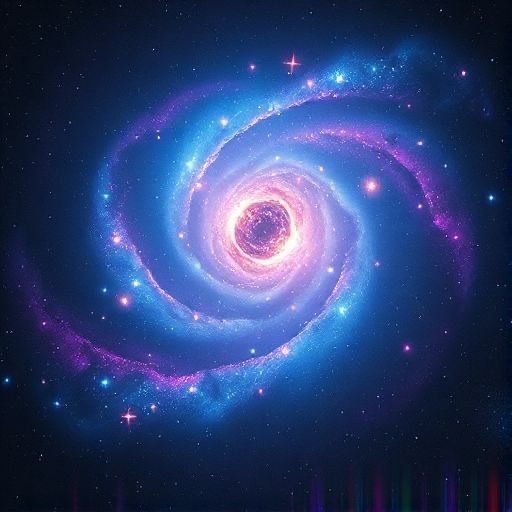
The Coma Cluster in the constellation Coma Berenices is a remarkably rich galaxy cluster. It is one of the most distant objects visible to the naked eye and contains a diverse population of galaxies. The high density of galaxies and the hot gas within the cluster make the Coma Cluster an ideal laboratory for studying cluster dynamics and the effects of gravitational interactions on galaxy evolution.

The Abell Catalog, compiled by astronomer George Abell, is a comprehensive list of rich galaxy clusters. Named after their discoverer, these clusters are crucial for mapping the large-scale structure of the Universe. Abell clusters such as Abell 02352 and Abell 03496 (the Hercules Cluster) are massive structures that contribute significantly to our understanding of the cosmic web.
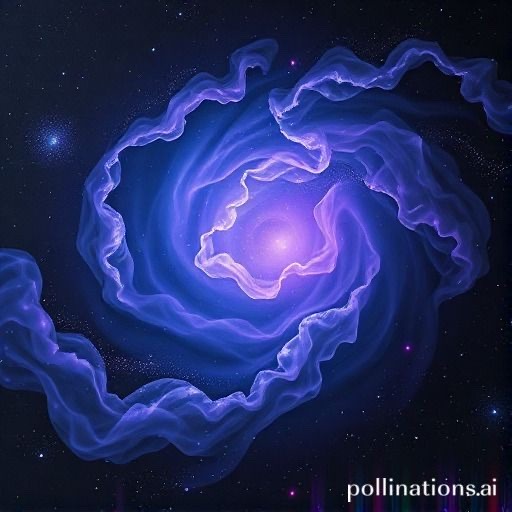
A critical aspect of galaxy clusters is the presence of dark matter, a mysterious and invisible substance that makes up most of the mass of these structures. The gravitational influence of dark matter is enormous, as it holds galaxies together in clusters and superclusters. In fact, most of the mass in galaxy clusters is dark matter, making it a dominant force in shaping the cosmic landscape.

The hot gas in dense galaxy clusters, the so-called intracluster medium, is a remarkable feature. Heated to millions of degrees, this gas emits X-rays that can outshine the light from individual galaxies. Studying this X-ray-emitting gas provides valuable insights into the temperature, density and overall mass distribution of the cluster. It is a powerful tool for astronomers to study the invisible dark matter and understand the dynamics of these massive structures.
As we travel through the local universe, we encounter superclusters, the largest known structures in the cosmos. Superclusters are vast collections of galaxy groups and clusters connected by galaxy filaments. They are the building blocks of the cosmic web, the complex network that spans the entire observable universe.

The Virgo Supercluster is our home supercluster, which contains the Local Group and the Virgo Cluster. It is a massive structure that spans 100 million light-years, making it a significant landmark in our cosmic neighborhood. The Virgo Supercluster is a crucial part of the larger Laniakea Supercluster, which defines our place in the cosmic web.

In 2014, astronomers defined the boundaries of the Laniakea Supercluster, a massive structure that encompasses and extends far beyond the Virgo Supercluster. Laniakea, which means "immeasurable sky" in Hawaiian, represents our cosmic home on a grand scale. Understanding superclusters like Laniakea is critical to mapping the large-scale structure of the universe and our place in it.
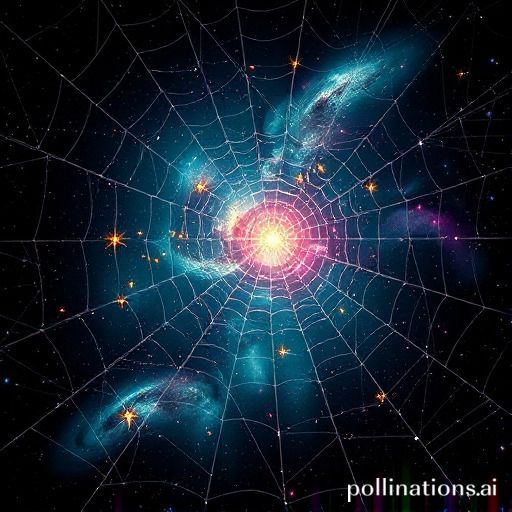
When we zoom in to even larger scales, we encounter the most extensive structures in the universe, including voids, filaments, and walls. These features form the cosmic web, a complex network that defines the distribution of matter in the universe.

Voids are vast, empty regions of space with few or no galaxies. They are the cosmic deserts separated by the complex filaments and walls of the cosmic web. Voids can extend for hundreds of millions of light years and are crucial for understanding the large-scale structure and evolution of the universe.
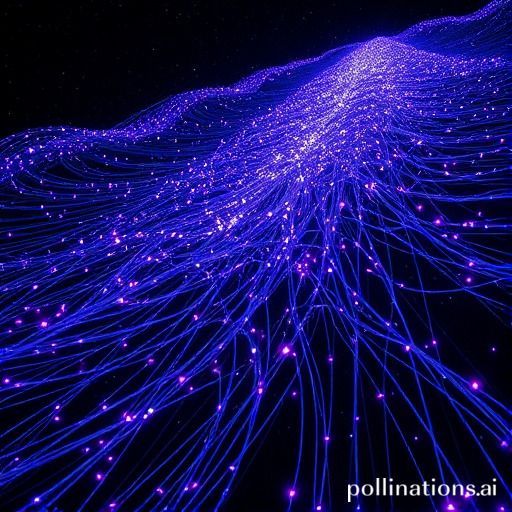
Filaments are long, thin structures that connect galaxy clusters and superclusters, while walls or sheets are relatively flat structures that contain numerous galaxies. These features form a cosmic fabric that determines the distribution of galaxies and superclusters. The "Great Wall" of Sloan, discovered by the Sloan Digital Sky Survey (SDSS), is a remarkable example of a huge sheet of galaxies that stretches for a billion light-years.
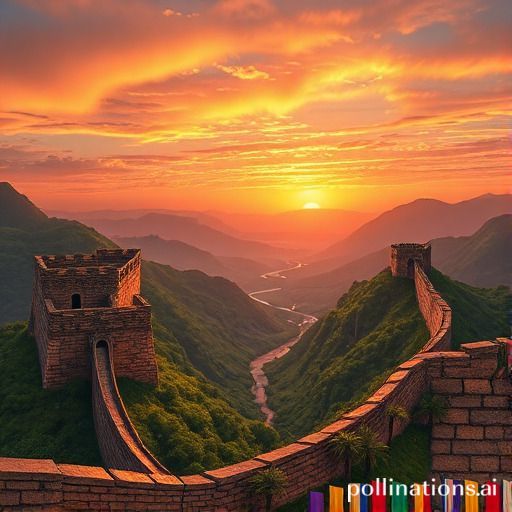
The Sloan Digital Sky Survey is a groundbreaking astronomical project that has revolutionized our understanding of the local universe and the cosmic web. SDSS has mapped the positions and distances of millions of galaxies, creating a detailed three-dimensional map of the cosmos. This survey has been crucial in identifying galaxy clusters, superclusters, and the complex filaments and voids that make up the cosmic web.
The local universe is a vibrant and dynamic environment filled with galaxies, groups, clusters, and superclusters. From the intimate interactions within the local group to the vast structures of the cosmic web, each element contributes to the grand narrative of the universe's evolution. Exploring the local universe allows us to understand our place in the cosmos and the complex relationships between celestial bodies. Studying galaxy groups, clusters, and superclusters provides valuable insights into the distribution of matter, the nature of dark matter, and the large-scale structure of the universe. As we continue to push the boundaries of astronomical research, the local universe will remain a crucial laboratory for testing our theories and expanding our knowledge of the cosmos. By unlocking the mysteries of our cosmic neighborhood, we come one step closer to understanding the vast and wondrous universe we inhabit.
Groups and Clusters of Galaxies (Jason Kendall, April 2024)
youtube
Where is Everything in The Universe Going? (History of the Universe, October 2024)
youtube
Sunday, October 13, 2024
#local universe#Youtube#galaxy groups#galaxy clusters#cosmic web#voids#filaments#astronomy#astrophysics#ai assisted writing#machine art#great attractor#presentation
2 notes
·
View notes
Text
The Abyss Chasers - Revised 3.0
(( Hello heretics! Haven’t been as active but I am still whittling away at my usual 40k hobbying. Some months ago I made a big post about my homebrew warband, well a little bit ago I’ve finally complied it into something I’m relatively happy with. More story feeling. Hope you like it! I am also planning on writing a few 40k fics in the future to rekindle my passion for this little world I’ve made! ))
++
Chaos God: Chaos Undivided
Allegiance: Chaos
Founding: 999.M32
Numbers: roughly 1000-2000 marines and untold thousands of the Lost and the Damned
Leader: Silas Decurin, The Abyssal Lord
Home World: Vorago; Former Maiden World
Allies:
Sons of the Serpent
Rot Heralds
Brazen Skulls
Helsson’s Hounds
Battle Cry: Unknown
Colours: Black, Purple, & Silver
Pre-Heresy
Cognomen (Prior): Emperor’s Children
Home World: Chemos (Perditas)
Colours: Purple & Gold
“Let it be said that on this day we have finally cast aside the shackles of our past, our fathers and brothers, fallen so far into the depths they cannot see the stars, would weep at our achievements. We have claimed this world in the name of the Gods, in the name of our Legions, and in the name of our legacies. In the name of true glory, we shall bring ruin to the Imperium!”
- Lord Silas Decurin, at the Triumph of Vorago
The Abyss Chasers are an infamous Chaos Warband formed in the bloody age shortly following the Horus Heresy. During the Great Crusade and later Horus Heresy, the warbands eventual leader, Silas Decurin , was a captain of the Third Legion, the Emperor’s Children. Along with the rest of his brothers, Silas would sink into the depravity and excess the legion would become known for, under the sway of the Dark Prince Slaanesh. He fought in many of the major battles the Third were known for, such as Isstvan and even the Siege of Terra. When the Heresy ended and the Traitor Legions soundly defeated, Silas accompanied his brethren fleeing to exile in the Eye of Terror. There the future Abyssal Lord witnessed the Emperor’s Children further splinter, and fall apart entirely, scrabbling to survive. Awakening to the reality of the path he had fallen upon, Captain Decurin took his company and broke away from Fulgrim’s Chosen. If the remnants of the legion even noticed, Silas did not care. Over the next ten thousand years, he would gain allies and build a new force, attempting to return the Third Legion to the glory they deserved, trying to keep his brothers united despite their fracturing minds and souls, the galaxy their birthright, whilst also struggling against the corrupting, twisting influence of the Dark Gods that he and many swore allegiance to in this new, grim age.
Warband History
1. Remembrance
During the Great Crusade, the company Silas led gained many honours, fresh souls born of Chemos and raised under the light of the early Imperium. Notably fighting alongside the Sons of Horus, due to their Primarch-Father’s close friendship with the Warmaster. Captain Silas Decurin was particularly noted for his ability as a poet, even amongst his brothers of the artistic and proud Third Legion. Captain Decurin is also known to have made a friendship with a Remembrancer attached to his company, and the pair recorded many of the early campaigns in a flowing prose.
2. Heresy
It was upon the alien planet Laer that Captain Decurin and his company would be forever changed, the taint of Slaanesh falling like a shroud upon the legion. Not long from there the Warmaster’s rebellion would begin, and the company would battle throughout the Galaxy at the behest of their primarch and their leaders. Most notably Isstvan III and V, and the Siege of Terra. Along with the rest of the traitors, they would flee into the Eye of Terror after the failure of the Siege.
3. Legion
In the Eye of Terror the former united legions splintered, squabbling and fighting amongst themselves. The Emperor’s Children, fully lost to depravity, barely even noticed their fall finally sealed for the rest of time. Captain Decurin and his company were entirely in the thrall of the Dark Prince, and it would take some time for this to change, the company practically fighting on their own. Time is fickle in the warp, and it's hard to say how much time truly passed, but eventually Silas awoke to the truth, seeing how utterly ruined the legion he once saw as the finest Astartes in the Galaxy had become. At the end of the aptly named ‘Legion Wars,’ Silas would take his company and truly break away from the remnants of the Third Legion.
4. Warp
For centuries the scraps of the company would travel the currents of the warp, emerging to raid isolated worlds, void-stations, and supply fleets, and conserving their greatly diminished strength. By this point the small fleet they had was reduced to a single strike cruiser, the flagship of the company, the Echo of Glory. To the sons of Fulgrim still with minds to recall, and the former captain, they felt as though merely a century had passed, a short time in the near-immortal forms of the Astartes. When they would finally track the time in real-space, they would find nearly a millennia had passed. Drifting along the winds this would continue, the company slowly being corrupted by the malign influence of Slaanesh. Captain Decurin would struggle to keep them all on the same path, like a family watching helplessly as a loved one succumbed to addiction. Their numbers would only further diminish, a full company dropping to maybe fifty battle-brothers by the end of the thirty-second millennium.
5. Allies
Moving into millennium thirty-three, Captain Decurin was on the verge of abandoning his endeavour, the whispers of Slaanesh nearly impossible to ignore, pressing upon his mind to merely return to the Eye and join his gene-father and spiral into the depths of damnation. This changed with an unexpected arrival. On a piratical raid of an Imperial void-station, the company encountered a single frigate on the far end of the solar system they resided in. This frigate belonged to the newly formed ‘Sons of the Serpent’ warband. A faction of the enigmatic twentieth legion, the Alpha Legion. The leader of this group introduced himself as Alpharius, as the masters of misdirection always did, after Captain Decurin pressed the warlord to drop the antics, the Alpha Legionnaire would re-introduce himself as Naethar Sestus.With the aid of Sestus and his company, Silas would find some relief, and his numbers bolstered as the Alpha Legion soldiers offered an accord to band together.
6. Abyss
Some time later, the level-headed, and seemingly uncorrupted Sestus advised that Captain Decurin truly disconnect himself from the past that could no-longer be reclaimed. Silas understood that clinging to the past would not bring back the glory he knew his brothers could achieve, and thus did he rename the company, The Abyss Chasers were born, if they would be damned, they would be the hunters of the depths, not the victims. The strike-cruiser flagship would also be renamed, an acknowledgement of the god that Decurin could never truly escape from, the Echo of Ecstasy.
7. The Left Hand
On a forgotten world, now dead, the Abyss Chasers and their allies would fall upon the innocents of the Imperium. It is said a single boy stood against the Abyssal Lord, noting his courage and psychic potential, Silas would take the boy and through the baleful magics of the Empyrean, and lost sciences, raise the child to the ranks of the Astartes. Now called Vezeral, who would become one of the warbands finest leaders, and close advisor of Lord Silas. Vezeral in his risen form is a master psyker, a sorcerer of Chaos who utilizes the magic of the Dark Prince as easily as he uses his wargear.
8. The Red Hand
In the following centuries, in a tale now lost to time, the Brazen Skulls warband would splinter off from the Twelfth Legion, the World Eaters. This warband was led by Tyrax Revka, once a proud captain, now feeling the bite of the Butcher’s Nails just like the rest of his brothers. Tyrax would encounter the newly formed Abyss Chasers and their leader Silas. For reasons known only to the pair, either an understanding, a duel, or anything in-between, the berzerker lord would offer his allegiance and the forces of his warband to the Abyssal Lord, further strengthening the growing Chasers with the warriors of the Blood God. This also marked the first time the warband could be called an Undivided force.
9. Corruption
Despite the best efforts of Lord Silas and his advisors, he could not stop the endless march of the power that is the warp. The tenuous alliances of Heretic Astartes would only indulge their dark desires, bloodlust, and other whims as time went on. Even the Abyssal Lord himself was not immune, as the taint of Chaos can never be removed once it takes hold. Daemons run rampant in the depths of the Echo of Ecstasy, and the brothers of the warband mutate and twist. Silas constantly teeters on the edge of sanity at all times, keeping the Abyss Chasers together. His goals remain ever the same, but the methods grow more brutal and depraved. The honour he once sought out would forever be lost, but the glory, now that could still be attained. In response, the advisors formed the Council of Claws to keep the drifting mind of their leader on the correct path.
10. Judgment
In the Galactic North, Segmentum Obscurus, was a region of Imperial space known as the Judicium Sector, small but well traveled and fortified by various forces. In 988.M41 the Immaterium would once more spit out the twisted vessels of the Abyss Chasers, and they made their way towards the agri-world of Riothea. The planet would be raided by the warband and razed to near destruction. The local PDF held for weeks until the timely arrival of Astartes assistance in the form of the Marines Exemplar chapter. The Abyss Chasers would battle the loyalists for weeks, eventually being forced to withdraw. To the Imperium it is unknown why the heretics attacked the planet, to the Council of Claws, it was to test the defenses of the Sector, and the response times of the servants of the Corpse-Emperor.
998.M41 would see their return, a trail of worlds were razed by the warband before coming into fire with Judicium's battlefleet, and the Abyss Chasers were forced onto the capital planet Rubedo where a lengthy engagement continued for months. The local Planetary Defense Force was eventually aided by a detachment of Adepta Sororitas from the Order of the Black Sepulchre, and the Atropan 985th Imperial Guard Regiment. The fighting grew so intense that a company of Adeptus Astartes were even deployed, from the Flesh Tearers chapter. This great conflict would become known as the Scouring of Judicium, the largest engagement the warband had ever fought in since the ancient days.
11. Maiden
After being pushed back to the Eye of Terror, the Abyss Chasers were battered but succeeded in their goal, while they recovered they examined their discoveries. Just beyond the edge of the sector, close to the Eye, they had discovered a world that was held in secret by the Imperium’s foul Inquisition, never traveled and dubbed ‘taboo’ due to its connotation. An Aeldari Maiden World called Blathdahan. The mostly Slaaneshi forces could not pass up such a prime chance to bring carnage to their ruinous mistresses' most delicious foes. At the command of Lord Silas and the Council of Claws, the fleet, and the Echo of Ecstasy began the journey through the warp to find the hidden world.
12. Witch
The warband discovered the world after pinpointing coordinates stolen from Rubedo, and fell upon the lush, green world with all the wrath of the Ruinous Powers. The world would not take it lying down however, as the native Aeldari, called ‘Exodites’ fought back against their kind’s most feared enemies. Heretic Astartes and mortal cultists fought against wild xenos and their dinosaurid mounts and pets. The battles raged across the surface for weeks, but the corrupting influence of the unleashed warp eventually wore down the Exodites, and their planet would fall to the full force of the Abyss Chasers and all their accumulated allies, including the original advisors, as well as the Rot Heralds of Nurgle, and the Scions of Dawn of Tzeentch. Chaos Undivided conquered the world, and Lord Silas would lay claim to it. A hidden world known to few, a perfect foothold to launch even greater devastation upon the dogs of the corpse-god. The fallen Maiden World was renamed ‘Vorago’ from an old Chemosian word for ‘witch.’
13. Port of Call
Similar to other Chaotic ports of its kind, Vorago would quickly grow due to its proximity to the Eye. More arrivals and allies came to the banner of the Abyssal Lord. A renegade Knight known as the Violet Tear, the warband of Heretic Astartes known as Helsson’s Hounds, who are former sons of Russ, and many, many others. With the numbers swelled, the warband was no longer that broken shadow of the Third it used to be, so long ago. At the centre of the former Exodite city was a temple to their xenos gods, now renamed ‘Cordomus’ and transformed into a dark temple, and fortress, to the four gods of Chaos. In the centre of that bastion, is the throne-room of Lord Silas Decurin.
14. Thirteenth Black Crusade
In 999.M41, before the warband could begin any further plans, Lord Silas was contacted by an emissary of the new Warmaster, Abaddon the Despoiler. This envoy told the Council and the Lord of the incoming Black Crusade, the Warmaster’s attempts to attack the gates of Cadia and ram down the doors of the Imperium. Lord Silas was always unsure of the Black Legion, but he understood that Abaddon had similar aspirations, to finally bring an end to the Emperor that forsook them so long ago. The Abyss Chasers agreed to the accord, and would sail to join the Black Legion in their great siege of Cadia. It is noted they took up the colours and banners of the Warmaster’s forces during this brief period, alongside the many other groups that came to Abaddon’s call.
15. Dark Millennium
After the 13th Black Crusade came to a galaxy-shaking conclusion, the Abyss Chasers would break away from the Warmaster of Chaos’ forces and return to Vorago. Their journey was fraught with calamity as the massive warp-wound named by the Imperium as the Cicatrix Maledictum tore itself across the stars. Battered by the end of the trek, Lord Silas and the Council of Claws decreed the warband lay low for a time. Of course, the silence did not last long as only a few standard years into the new age the forces sworn to the Abyssal Lord once again began their raids. The Judicium Sector plunged into shadow as a result of the Great Rift.
16. Advent
“My brothers, we have received word of something most dire. The wretched son of the False Emperor, Roboute Gulliman, a thousand curses upon his name, lives again. Alongside him came an abomination to our perfect forms, the so-called ‘Primaris Marines.’ We will show the lapdogs what true Astartes look like, and pray to the Dark Gods that foul Gulliman meets his true and final end.”
- Lord Silas Decurin, addressing the Abyss Chasers
As the 42nd Millennium began its cycles, the Abyss Chasers would first meet Gullimans Primaris on an outskirt world called Drenades. These new marines clashed with the fallen first and showed how powerful they were despite the difference in experience. Outwardly Lord Silas would show disgust and disdain as many of the Heretic Astartes did across the galaxy, but silently he wondered if their power could not be turned to a better purpose, a purpose of enacting the will of Chaos.
Experiments would begin in the secret levels of Cordomus, under the watchful eyes of the Chasers’ Apothecaries. Indeed, Silas would even hear word of the great and terrible Fabius Bile attempting similar testing, and would wonder how perfect they could be if such creatures were created.
More and more conflicts arose across the neighbouring sectors as the forces of the Imperium pushed their way across the Cicatrix Maledictum, but the Abyss Chasers heeded it little, as always their purpose was personal glory in the name of the gods.
17. Endless War
All across the galaxy war erupts, grim and bloody and full of the laughter of the gods. Octarius saw Tyranids defeat and devour the Orks that held it for ages, the Realm of Ultramar came under siege by the noxious forces of the Death Guard, and a region of the Nephilim Sector falling to all-out carnage as the Necron xenos created the Pariah Nexus. As always, the Abyss Chasers continue their raids into the Judicium Sector and its surrounding regions, now contending with Primaris Marine bolstered chapters and renewed Inquisition forces under the Ordo Hereticus. They do not stand alone however, Vashtorr the Arkifane sending daemonic envoys to Vorago, as well as others to neighbouring warbands. Their numbers increased with the techno-arcane horrors of the aspiring god. There are also the ever-flowing arrivals of lost and damned, demigod and mortal alike. War is eternal, war is ecstasy, and the Abyss Chasers welcome it always.
#warhammer 40k#40k#warhammer#chaos#slaanesh#fic writing#ask the abyssal lord#Silas Decurin#Decurin Energy
3 notes
·
View notes
Text
Messier 32, A Spiral Without it's Arms ?
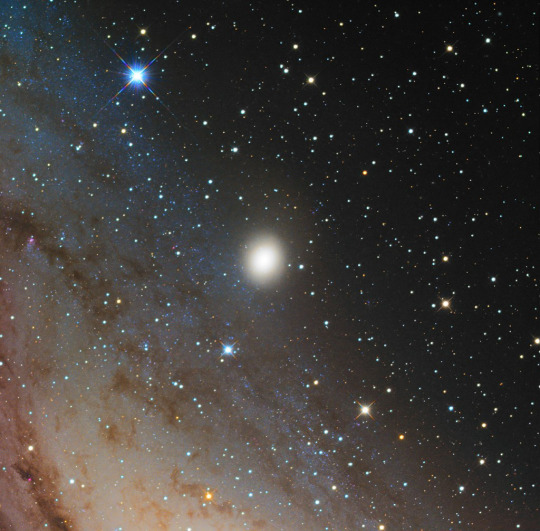
Andromeda Galaxy M31 contains another Messier object, M32, an elliptical dwarf galaxy, but it mostly defies explanation.
One theory proposes that the main galaxy stripped the arms billions of years ago, but the central stars in the galaxy were pushed further together, and have formed a galactic sized globular cluster.
The colour of the object that cream colour is certainly similar to that we see at the centre of galaxies.
However, despite it's rarity, there have been a few others found, and they exist without galaxies to explain them, although it is always possible the remnants escaped a galaxy in the past and was thrown out.
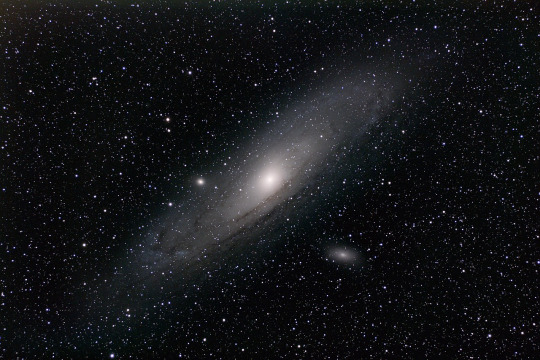
M32 is the small orb just left of the galaxy's core, out towards the halo, interestingly where many globular clusters lie too.
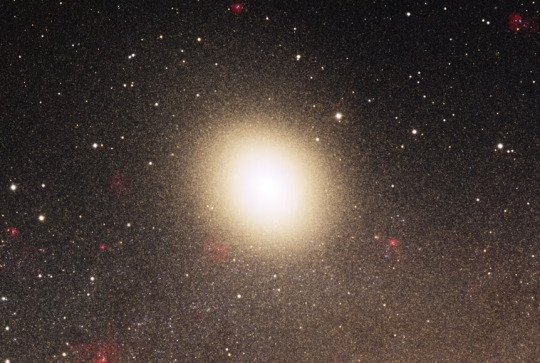
In fact, you'll recall from the M31 post yesterday that the galaxy is made up of two distinct populations of stars, and some theorize that it's M32 that was the cause of this.
45 notes
·
View notes
Text
M31 - The Magnificent Andromeda Galaxy and Friends (M32 & M110). This image was taken using 100 60 second exposures using a RASA 8 F/2 Telescope and a ZWO ASI2600MC Pro Camera. The data was pre-processed in Astro-Pixel Processor, post-processed in PixInsight and Photoshop. #astrophotography
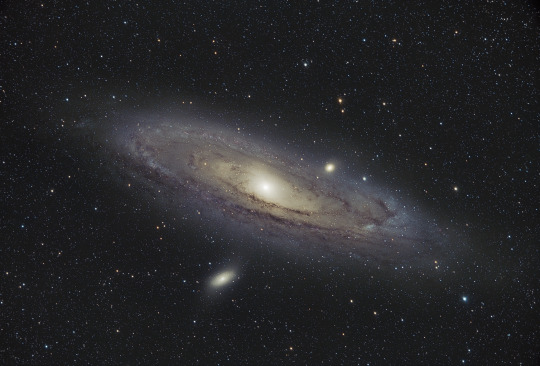
5 notes
·
View notes
Text
Price: [price_with_discount] (as of [price_update_date] - Details) [ad_1] Product Description WAYONA USB C to USB C 65W Short Nylon Braided Fast Charging Cable for Powerbank, Mobile, Laptop, Car etc. 65W/3.25A Fast Charging & 480Mbps Data Sync: Transfer speed up to 480Mb/s, 3.25A Fast Charger Cable and Power Charging 2 in 1, supports fast charging from both sides of type C connector. Important Notes: 1. This is a USB C to USB C cable NOT USB C to USB A cable, so you need a Wayona USB C PD wall charger to charge your device. 2. To ensure fast charging speed of your device, please use the charger which can supports QC 2.0/3.0 or PD (Power Delivery) fast charging. How to Achieve Fast/Quick Charge? To achieve quick charge, you may need a USB C PD or QC 3.0 or fast charger adapter, and your phone needs to support PD or FCP or QC 3.0, AFC Fast Charge Protocol. Incredibly Durable: Unique premium Nylon Braided USB C to USB C cable adds additional durability and tangle free with the reinforced connector withstands 10,000+ bend and 10000+ plugging and unplugging test. Safe Charging & High Speed Data Sync: With upgraded intelligent chip inside, our Wayona type c to c charger cable provides reliable conductivity with more stable charging current and 480 mbps high speed data transfer which it is also flexible enough to be wrapped up and put in a bag. Compatible Devices : Please Note This is a USB C to USB C cable (Both Ends USB C Port), so this cable cannot be used with a Normal USB A Charger/Powerbank. Samsung Samsung Galaxy S20, S20Plus, S20Ultra, S20 FE 5G, S21 Ultra 5G, Note 10, Note 10 Lite, Note 20 Ultra 5G, S8, S8 plus, Galaxy S9, S9 plus, S10, S10 plus, S10e, S10 Lite, M11, M52 5G, M21, M31, M31s, M52 5G, M32 5G, M12, M51, M42 5G, M02s, M62, M22, F42 5G, F62, F41, F12, F02s, F23, M33, M23, A23, A13 5G, Tab S8 Ultra, Tab S8+, Tab S8. Xiaomi Xiaomi Note 10, Note 10 Lite, Note 10s, Note 10 Pro, Note 10 Pro Max, Note 10T 5G, Note 8 Pro, Note 9, 8, 7 Series Note 10, Note 10 Lite, Note 10s, Note 10 Pro, Note 10 Pro Max, Note 10T 5G, Note 8 Pro, Note 9, 8, 7 Series, K20, K20 Pro, K20, K20 Pro, Redmi Note 11, 11T 5G, 11 Pro. Vivo iQOO iQOO Z6, 7, 9 Series, Z3 5G, Z5.
Samsung A10e, A20e, A20, A20s, A21, A21s, A30, A31, A30s, A52s, A40s, A41, A50, A50s, A51, A71, A71 5G, A70, A70s, A60, A80, A81, A90, A91, A13 5G, A03, A03s, S22, S22 Ultra 5G, S22+, S21 FE 5G. OnePlus OnePlus 9, 9R, 9 Pro, 9RT 5G, 8T, 8T+ 5G, Nord CE 2 5G (Warp Charging) Apple iPad Air/Pro having Type C charging port. Samsung A01, A11, A3(2017) , A5(2017), A6(2017), A7(2017) , A8(2018) , A9(2017,2018 ,2019) , Note 8 , Note 9 , Note10 Lite , Note 20 , Note 20 Ultra , Z Fold2 5G, Z Fold3 5G, Galaxy Z Flip 5G, Z Flip3 5G. Other Phones & Laptops Can also be used in many other phones or laptops having Type C ports or in Car (Android Auto/ Apple Car Play) or in Powerbank. 【NOTE before purchase】: This is a USB C to USB C cable, which means it has the same USB C plug on both ends, please be aware that this is not a USB-C to USB-A cable. Besides, you may need a USB C wall charger to charge your device. 【Short and Compact Length】: 0.25M short length, convenient to use with Power Bank.Easy to use for data transfer on laptop as well. 【Fast Charge and High-Speed Data Sync】: This USB C to C Cable supports Fast Charging/Quick Charge (QC) up to 65W 20V/3.25A, which charges your phone and laptop with USB C ports at high-speed. It offers transfer speeds at 480Mbps 【Reliable and Stable】: This USB Type C Fast charging cable is made of premium nylon, adding additional durability and tangle-free, can bear 10000+ bending test. 【Compatibility List】 : This Type C to Type C cable can fast charge your iPhone 15 15 Pro 15 Plus 15 Pro Max Samsung Galaxy S25 Ultra S24 S24 Ultra S24 Plus S23 S22 S21 S20 FE 2022 S20 /S10/ S20+/ S20 Ultra / Note 10 / Note 10 Plus / A80 , A71, A51, M31s/ Compatible with iPad Pro 2018/2019/2020, MacBook 2015/2016/2017, MacBook Pro 13'' 2017/2018/2019/2020 with the help of USB C Adapter. [ad_2]
0 notes
Text
New features on Galaxy M32 after updating One UI 5.1
Recently, Samsung has released the One UI 5.1 update for all its devices. Besides improving security, this update also brings many new features to some devices. Here are some notable features on the car Galaxy M32 When updating One UI 5.1. Improve multitasking: When proceeding to split the screen, One UI 5.1 will prioritize displaying the applications you often use before. In addition, you can…
0 notes